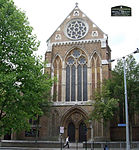Queen's Crescent Market

Queen's Crescent Market is an outdoor street market held every Thursday and Saturday on Queen's Crescent in Kentish Town, Camden between the junction with Malden Road in the West and the junction with Grafton Road in the East. Licences to trade are issued by Camden London Borough Council. The market sells food, discounted clothing and a wide variety of household products. In 2011, the Camden Council database reported 77 sites.Many traders run stalls that have been passed from generation to generation. This is in contrast to the much more recent and considerably more famous Camden markets nearby, which primarily attract tourists and those from other parts of London). Aesthetically Queen's Crescent market is a mixture, with pretty plain white houses sitting side by side with large council estates, some of which sit in beautifully landscaped grounds.
Excerpt from the Wikipedia article Queen's Crescent Market (License: CC BY-SA 3.0, Authors, Images).Queen's Crescent Market
Queen's Crescent, London Chalk Farm (London Borough of Camden)
Geographical coordinates (GPS) Address Nearby Places Show on map
Geographical coordinates (GPS)
| Latitude | Longitude |
|---|---|
| N 51.5488 ° | E -0.1534 ° |
Address
Cheriton
Queen's Crescent
NW5 4EZ London, Chalk Farm (London Borough of Camden)
England, United Kingdom
Open on Google Maps










